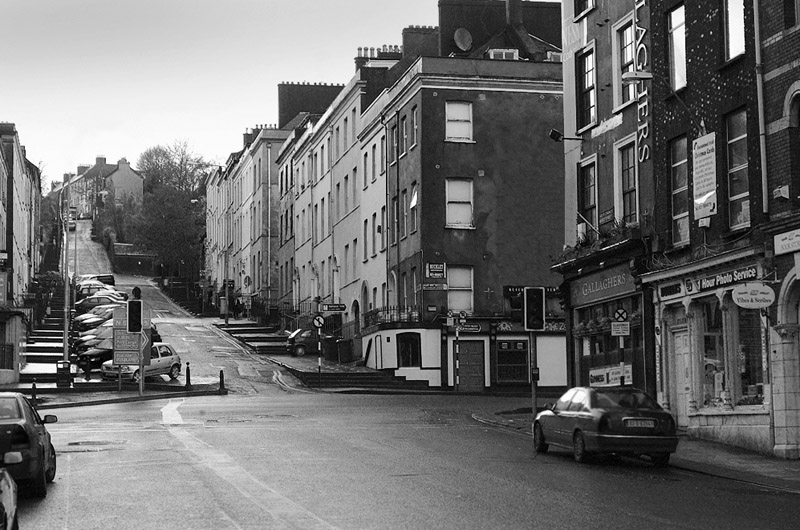British Army General Evades Capture by IRA
The junction of Patrick's Hill and MacCurtain Street where the attempt to capture the general was made.
While Terence McSwiney was on hunger strike an attempt was made to capture Major-General Strickland and hold him hostage with a view to obtaining MacSwiney's release. The men selected for the operation were Dan 'Sandow' Donovan, Michael Kenny and the Grey brothers, James and Jeremiah, all of whom were members of the Active Service Unit of the 1st Battalion, 1st. Cork Brigade. Sean O'Hegarty, who took over from McSweeney as commander of the brigade, headed the operation. General Strickland often travelled to England on military business. On these occasions a touring car would take both the general and his aidede-camp (ADC) from Victoria Barracks to Penrose Quay via Sidney Hill, Wellington Road, Patrick's Hill and MacCurtain Street. On arrival at the quay he would board the passenger steamer the SS Bandon, which usually departed Cork at 5.30p.m. each evening.
Michael Kenny was a member of the brigade intelligence squad and would be able to recognise Strickland and the car in which he usually travelled. O'Hegarty's plan was for Kenny to position himself near the junction of Wellington Road and Patrick's Hill and act as a scout. The remainder of the attack party would wait at the bottom of the hill. When Strickland's car reached the bottom of Patrick's Hill the Grey brothers would jump onto the running board on the driver's side and take over the vehicle at gunpoint. O'Hegarty and 'Sandow' Donovan would rush the car from the opposite side and capture the general and any other officers who might be with him. The general and his fellow officers would then be bundled into two waiting cars and transferred to a location in a remote part of the countryside outside Ballincollig where they would be held.
The attempt to capture Strickland would be made as his car slowed down at the bottom of Patrick's Hill before turning on to MacCurtain Street. O'Hegarty and his men took up their positions on the afternoon of Thursday 9 September. All would be armed with revolvers. They remained in position for a number of days but there was no sign of Strickland. By 24 September MacSwiney had been on hunger strike for 42 days and his condition was weakening. O'Hegarty and his men had been in position for two weeks and were getting anxious. Convinced that another day would end without sight of their quarry O'Hegarty's men had relaxed somewhat. However, at around 5.45 p.m. Michael Kenny caught sight of Strickland's car making its way down Wellington Road. All the occupants were dressed as civilians. The general's aide-de-camp sat in front next to the driver. Strickland was in the back seated between another staff officer and Captain Kelly, the divisional intelligence officer. Kenny tried to alert the Grey brothers by means of a prearranged signal but failed to attract their attention.
As the car turned down Patrick's Hill, Kenny continued to signal but his efforts were in vain. In desperation he drew his revolver and ran after the car, hoping to jump onto the running board. The staff officer in the rear of the car alerted the driver to the danger while drawing his revolver. As the car pulled away Kenny and the officers in the rear of the car exchanged fire. The sound of gunfire alerted O'Hegarty and his men and they drew their weapons. The Grey brothers joined Kenny and opened fire towards the rear of the car while O'Hegarty and 'Sandow' Donovan fired at it from the side. As pedestrians scattered, a close-quarter gunfight developed between O'Hegarty's squad and the occupants of the car.
During this exchange General Strickland was hit in the shoulder. The driver of the car was badly wounded but succeeded in getting his vehicle on to MacCurtain Street. The windscreen and side windows of the car were shattered. Bullets smashed into the windows of a licensed premises on the corner of Bridge Street and other shops. One civilian was wounded by stray gunfire. As the car made its way down MacCurtain Street it collided with a pole but managed to stay on the road. The IRA chased the car half way down the street, maintaining fire as they ran. When the car reached the end of MacCurtain Street, O'Hegarty called off his men. The entire incident had lasted about two minutes and General Strickland and his staff had a miraculous escape. Even had the plan succeeded, it is unlikely that the British would have released MacSwiney. In that case, the IRA would probably have executed Strickland and the other officer and British reprisals against the people of Cork would undoubtedly have been severe.
O'Hegarty considered the operation a failure. Whatever hope was had of negotiating MacSwiney's release from prison had disappeared. On the morning of 25 October 1920, after seventy four days without food, Terence MacSwiney died in prison.




